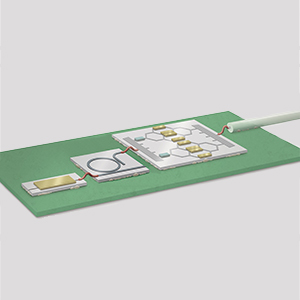Solar energy technologies are the technological pillars for the future supply of renewable electricity in Germany and worldwide. One of our key strategic goal is to ensure that photovoltaics will provide the lowest levelized cost of electricity of all energy technologies.
Scientific Topics
Energy-Efficient Lightning
Next Generation Photovoltaics
Highest Efficiency Metal Halide Perovskites
Involved Institutes: IMT | LTI
Optical communication networks form the backbone of today’s digital society and represent the technical foundation of megatrends such as cloud-based services and business models, ubiquitous wireless connectivity, the Internet of Things, and the digitalization of industrial production processes, often referred to as “Industry 4.0”.
“Communications and Connectivity” focuses on building the technological foundation of such research by offering access to cutting-edge wafer-level nanofabrication technologies as well as to facilities for advanced packaging and assembly of ultra-broadband photonic-electronic systems.
Scientific Topics
Optical Communications at Unprecedented Speed
Ultra-Broadband Photonic-Electronic Systems
Photonic 3D Integration
Hybrid Integration of Electronics and Photonics
Involved Institutes: IPQ | IPE | IAI
“Information Acquisition in Life Science” addresses fundamental questions of molecular, cellular, and organismal biology, biomedicine, and biotechnology. The advanced light microscopes operated at KCOP enable analytical approaches for applied KIT projects in the area of life science engineering and bio-relevant materials.
Besides light microscopy techniques, “Information Acquisition in Life Science” also aims at leveraging microtechnological approaches and photonic integrated circuits for information acquisition in life sciences. Research activities comprise, e.g., waveguide-based biosensors and associated light sources for point-of-care diagnostics and microscale devices nuclear magnetic resonance (NMR) spectroscopy.
Scientific Topics
Biological Processes on a Molecular Level
Super Resolution Light Microscopy
Two-Photon Microscopy
Light Sheet Microscopy
Correlative Multi-modal Microscopy
Involved Institutes: APH | IBCS-BIP | IMT
Progress in any experimental science relies on measurements and, thus, on sophisticated sensor and detector systems. Advanced detector and sensors systems influence our daily lives and are ubiquitous in society, industry appliances, or manufacturing machines. Custom-made detector and sensor systems are key elements in fundamental research where detector systems are often large and expensive like in particle or astroparticle physics. “Information Acquisition in Industry and Research” intends to find the best solutions to these challenges.
Scientific Topics:
“Big Data” in Science and Industry
New Packaging and Interconnect Technologies for Massively Parallel Sensor Systems
Tailored Production Processes for Advanced Detector and Sensor Systems
Sensors Large-Scale Particle Detectors
Involved Institutes: IPE
The outstanding performance of superconducting sensors is important to basic research, society, and industry on the national level. The production and characterization of high-resolution superconducting sensors specifically targets the ever-increasing demand for large-scale cryogenic sensor systems and will therefore be a key facility in bringing these types of detector systems to the next level of technology readiness. Superconducting sensors are expected to become an important tool for performing high-resolution spectroscopy on current and future brilliant light sources.
Scientific Topics
Quantum Computing
Quantum-Based Information Processing
High-Resolution Superconducting Sensors
Production of Large Quantities of Cryogenic Sensors and Related Superconducting Quantum Devices
Involved Institutes:
Involved Institutes: IPE | IMS
The paradigm change initiated by Johannes Gutenberg in the 15th century – by creating movable types rather cutting entire texts from a wooden block – was not just a technical advance, for it changed society by making information widely available. Digitally controlled three-dimensional (3D) additive Manufacturing, or loosely “3D printing”, has a similar potential as Gutenberg’s 2D printing. It converts information – a digital blueprint – directly into 3D matter, i.e., into materials, devices, and systems by appropriate instruments. Thereby, 3D Additive Manufacturing accounts for the ever-increasing societal importance of information, knowledge, and skills as economic capital compared to that of raw materials. “Digital Nano-Fabrication & Tailored Material” faces these challenges.
Scientific Topics
Additive Fabrication of Functional Nanostructures
Theory-Guided Material Design
3D Additive Manufacturing
Digital Nanofabrication Techniques
Involved Institutes: INT | APH | IMT | ITCP | Vanguard Photonics | Nanoscribe | ZEISS Innovation Hub | 3D Matter Made to Order (3DMM2O)




